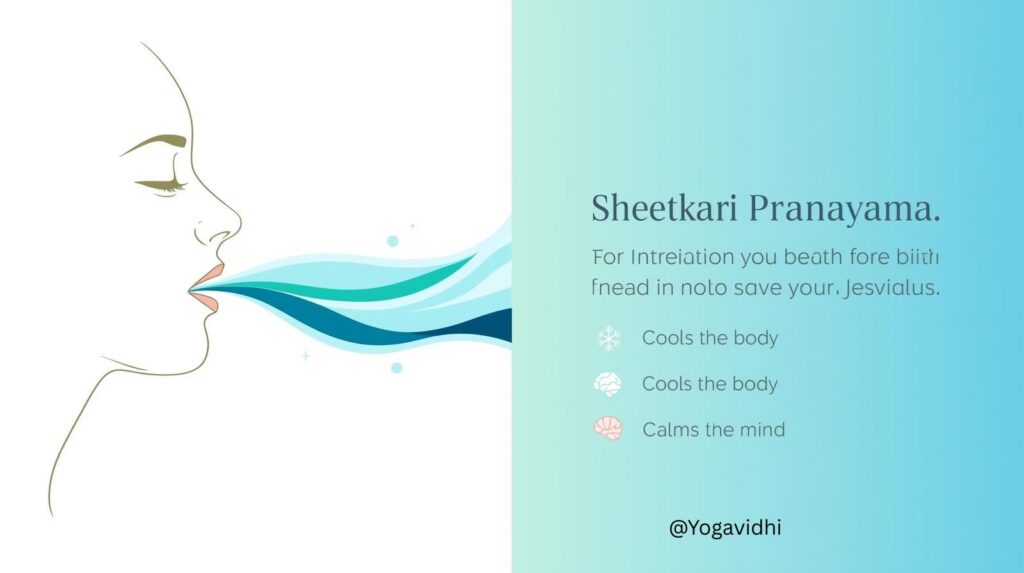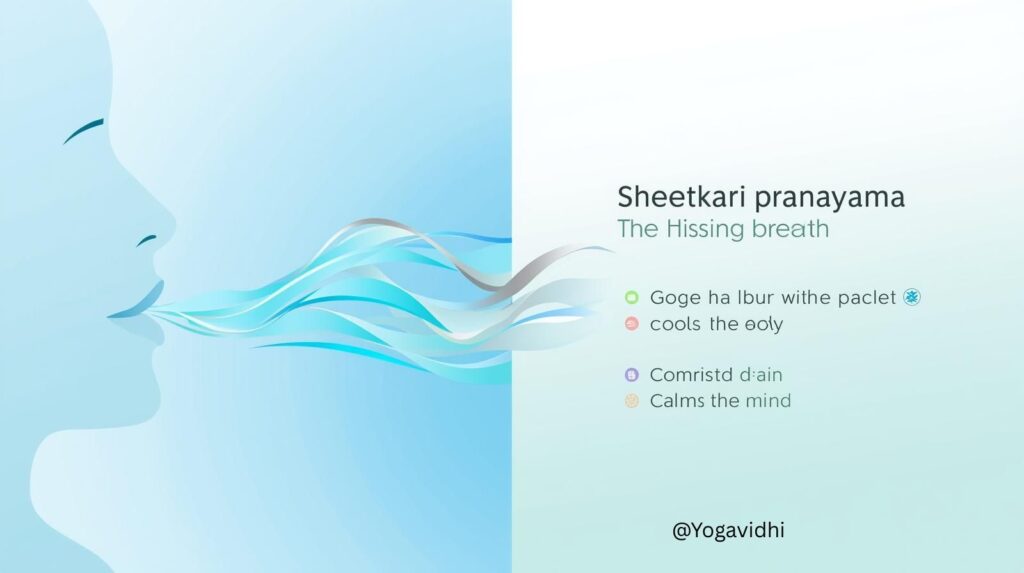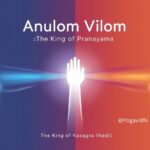When the summer heat drains your energy, or when stress makes your body feel overheated, yoga offers a natural solution—Sheetkari Pranayama. Known as the “Hissing Breath”, this ancient breathing technique is one of the most effective cooling pranayamas that balances body temperature, calms the mind, and rejuvenates the nervous system.
If you’ve ever wondered how to cool the body naturally with yoga breathing techniques, Sheetkari Pranayama is the answer. Practiced by yogis for centuries, it is simple, safe, and deeply refreshing when done correctly. In this guide, we’ll explore its meaning, benefits, step-by-step practice, precautions, and tips to make it part of your daily yoga routine.
Sheetkari Pranayama, also known as the “hissing breath,” is a cooling breathing technique where air is drawn in through clenched teeth, producing a gentle hissing sound that relaxes both the body and mind. To practice it, sit with your spine upright, keep your teeth closed with lips slightly parted, and inhale slowly while creating a soft “see-see” sound. This pranayama is highly effective for lowering body heat, soothing the mind, and relieving stress, making it especially beneficial in warm weather.
Table of Contents
What is Sheetkari Pranayama?
The word Sheetkari comes from Sanskrit:
- Sheet = cooling
- Kari = the act of producing
Hence, Sheetkari Pranayama is the “cooling breath” that produces a unique hissing sound when air passes through slightly clenched teeth during inhalation.
This pranayama is often referred to as the sister practice of Sheetali Pranayama, another cooling technique. The difference is that Sheetali involves rolling the tongue, while Sheetkari Pranayama uses the teeth, making it accessible to people who cannot roll their tongues.
Ancient yoga texts describe this as a powerful way to regulate body heat, purify the mind, and restore balance to the nervous system. It is especially recommended during hot weather, high stress, and emotional turbulence.
Benefits of Sheetkari Pranayama
Practicing this Pranayama regularly provides a wide range of physical, mental, and emotional benefits. Let’s look at the most impactful ones:
1. Physical Benefits
- Cools the body naturally – Reduces excess heat and is highly effective during hot weather.
- Improves digestion – Helps in reducing acidity, heartburn, and digestive discomfort.
- Relieves excessive thirst – A great aid in managing dehydration.
- Supports dental and oral health – Strengthens gums and teeth through controlled air passage.
- Lowers high blood pressure – By calming the nervous system, it gently reduces hypertension.
2. Mental & Emotional Benefits
- Calms the mind – Ideal for people suffering from stress, anxiety, and irritability.
- Controls anger – Its cooling effect helps manage emotional outbursts.
- Promotes relaxation – Deeply soothing for the nervous system.
- Improves focus and clarity – Brings mental sharpness by reducing agitation.
3. Therapeutic Benefits
- Relieves insomnia and restlessness – A natural sleep aid when practiced before bedtime.
- Balances the doshas (Ayurveda) – Especially beneficial for excess Pitta (heat element).
- Boosts energy without overheating – Restores vitality gently.
In short, Sheetkari Pranayama is more than just a yoga breathing technique—it’s a complete wellness practice for modern lifestyles.
How to Practice Sheetkari Pranayama (Step-by-Step Guide)
Practicing this pranayama doesn’t require special equipment—just a calm space and mindful breathing. Here’s how you can do it:
- Sit comfortably
Choose a meditative posture like Sukhasana (Easy Pose), Padmasana (Lotus Pose), or Vajrasana (Thunderbolt Pose). Keep your spine straight, shoulders relaxed, and hands resting on your knees. - Close your eyes and relax
Take a few deep breaths to settle your mind and body. - Position your teeth and lips
Gently press your upper and lower teeth together. Open your lips slightly so the air can pass through your teeth. - Inhale with a hissing sound
Slowly draw in air through the gaps in your teeth. You will notice a distinct “ssss” hissing sound as the cool air flows in. - Exhale through the nose
Close your lips, keep your mouth shut, and exhale slowly through the nostrils. - Repeat the cycle
Start with 5–7 rounds and gradually increase up to 15–20 rounds with practice. - Finish mindfully
Sit quietly for a few moments, observing the calm and cool sensation spreading through your body.
Pro Tip: Practicing Sheetkari Pranayama in the morning or evening ensures maximum benefits.
Read More: Surya Bhedana Pranayama – The Sun-Piercing Breath for Energy, Focus, and Vitality
Read More: Bhramari Pranayama – The Humming Bee Breath for Stress Relief and Inner Calm
Precautions & Contraindications
While Sheetkari Pranayama is safe and effective, it should be practiced with awareness. Keep these precautions in mind:
- Avoid in winter or cold climates, as it reduces body heat.
- Not suitable for asthma patients, people with chronic cough, cold, or respiratory issues.
- People with low blood pressure should avoid it, as it can lower pressure further.
- Pregnant women should practice only under expert supervision.
- Always practice on an empty stomach.
Best Time & Duration to Practice
For best results:
- Time of Day: Early morning or evening, when the environment is calm and temperatures are moderate.
- Season: Best suited for summer and hot climates.
- Duration: Begin with 3–5 minutes, gradually extending up to 10–15 minutes.
Difference Between Sheetkari and Sheetali Pranayama
Though both are cooling pranayamas, they differ slightly:
| Feature | Sheetali Pranayama | Sheetkari Pranayama |
| Technique | Inhalation through rolled tongue | Inhalation through clenched teeth |
| Accessibility | Only for people who can roll their tongue | Can be practiced by everyone |
| Sound | Cooling breath without hiss | Produces a hissing “sss” sound |
| Benefits | Cools body, improves digestion, relieves thirst | Cools body, calms mind, balances emotions |
Sheetkari Pranayama is often recommended as an alternative to Sheetali when rolling the tongue is not possible.
Tips for Effective Practice
- Practice in a peaceful environment free from noise.
- Combine this Pranayama with meditation for deeper relaxation.
- Keep your back straight to allow proper airflow.
- Do not force inhalation or exhalation—maintain a slow, steady rhythm.
- End with a few minutes of normal deep breathing or meditation.
Why You Should Add Sheetkari Pranayama to Your Daily Routine
In today’s fast-paced world, where stress, heat, and anxiety are common, Sheetkari Pranayama offers a natural cooling therapy. Unlike air conditioners or cold drinks that give temporary relief, pranayama works from within, balancing the body’s energy and calming the nervous system.
Regular practice can help you:
- Stay cool and composed in stressful situations.
- Improve sleep quality naturally.
- Balance emotions and prevent burnout.
- Enhance focus, productivity, and inner peace.

Conclusion
Sheetkari Pranayama is a simple yet powerful yoga breathing technique that cools the body, calms the mind, and heals the soul. Whether you’re struggling with summer heat, stress, or sleepless nights, this pranayama can be your natural remedy.
When practiced regularly, it not only improves physical health but also nurtures emotional balance and spiritual growth. The key is consistency—just a few minutes daily can transform your inner state.
So, the next time you feel overheated, anxious, or restless, skip the soda and try Sheetkari Pranayama—the natural air-conditioner within you.
FAQ:
Q. What is Sheetkari Pranayama?
Ans: Sheetkari Pranayama, also known as the “Hissing Breath,” is a yogic breathing technique that cools the body and calms the mind. It is practiced by inhaling air through slightly clenched teeth, producing a hissing sound, and then exhaling slowly through the nose.
Q. What are the benefits of Sheetkari Pranayama?
Ans: The main benefits of Sheetkari Pranayama include reducing body heat, calming the nervous system, lowering stress and anger, improving digestion, relieving excessive thirst, supporting oral health, and promoting better sleep. It is especially helpful during summer or in hot climates.
Q. Who should not practice Sheetkari Pranayama?
Ans: Sheetkari Pranayama should be avoided by people with asthma, chronic cough, cold, respiratory disorders, or low blood pressure. It is also not recommended during winter or for pregnant women unless guided by an expert.
Q. What is the difference between Sheetali and Sheetkari Pranayama?
Ans: The difference is in the technique. In Sheetali Pranayama, air is inhaled through a rolled tongue, while in Sheetkari Pranayama, air is inhaled through clenched teeth, producing a hissing sound. Both are cooling breathing practices, but Sheetkari can be practiced by those who cannot roll their tongue.
Q. When is the best time to practice Sheetkari Pranayama?
Ans: The best time to practice Sheetkari Pranayama is early morning or evening, on an empty stomach, in a peaceful environment. It is particularly effective in hot weather and can be practiced for 5–10 minutes daily for best results.
Q. How do you do sheetkari pranayama?
Ans: Procedure of Sheetkari Pranayama
Sit comfortably in any meditative posture with your eyes closed. Place the tongue upward, gently touching the roof of the mouth. Join the upper and lower rows of teeth together, then part your lips slightly and begin inhaling while producing a soft “see-see” sound.
Q. Does Sheetkari help with acidity?
Ans: Enhances Digestion: The soothing and cooling benefits of Sheetkari also support the digestive system. It aids in alleviating acidity, heartburn, and indigestion by calming the digestive organs.
Q. Does Sheetkari help with focus?
Ans: Enhanced focus and mental clarity: Practicing Sheetkari Pranayama requires mindful attention to the breath, which supports better concentration and focus. This technique is especially beneficial for those looking to improve memory, mental clarity, or attention span.
Declaration Note:
We use third-party videos and images on https://yogavidhi.com/ for educational and illustrative purposes. All rights belong to their respective owners. No copyright infringement is intended.




I’ll be referencing this in the future.